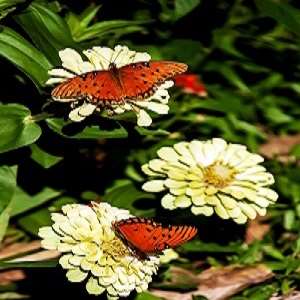By Norman Winter
After a hurricane, you find beauty and pleasure in simple things. In my case, it is the old-fashioned zinnia. Now I say “old-fashioned” because we grew them from generic seed packets, so I don’t know the variety. I would say it is the zinnia you grew up with as a kid.

If you are like me, zinnia was one of the first plants you grew from seeds, and you have to admit there is nothing prettier than the large flower. Over the years I have grown large amounts of Benary’s giant zinnias for cut flowers, and I can tell you that an acre of zinnias is a breathtaking site.
I love zinnias in single colors and I love them in mixes. I love them in dahlia form and in those we call “cactus.” At the University of Georgia Coastal Georgia Botanical Gardens and Historic Bamboo Farm, we planted our zinnias to add a different sparkle this year, if you will, to our pollinator beds. Lest you have forgotten, zinnias bring in butterflies just like other pollinator magnets. If you haven’t tried them in a while, they may surprise you.
So after Hurricane Hermine reached us as a tropical storm and Hurricane Matthew turned what seems to be the entire East Coast literally upside down, I do find pleasure in the large 4- to 5-inch-wide zinnias. They are blooming their hearts out, bringing in Gulf fritillaries and common buckeyes.
You may think it’s a little late to be talking zinnias, and it is over much of the country. Zinnias are champions for a long, hot summer, but they can also be sown as succession crops all the way to fall. They partner wonderfully well with other colorful fall bloomers like mums, Mexican bush sage and asters. You will notice they bloom before and after mums, and they are downright inexpensive.
Maybe the point of this article is to remind you to introduce your children to this incredibly beautiful flower next spring. This is one flower that can create a gardener in little ones. Use it to introduce children to butterflies and the pleasure of having fresh cut flowers on the table.
Whether you choose a package of generic zinnias sold by color or a mix or you find Benary’s giants, Dreamland or the Magellan series, know they prefer full sun to really put on a dazzling performance. Prepare flower beds by incorporating 3 to 4 inches of organic matter and 2 pounds of a slow-release 12-6-6 fertilizer per 100 square feet of bed space. Direct seed or set out transplants with little to no color showing.
Thin seedlings to around 6 to 8 inches for the vigorous growth that is about to occur. Mulch when the seedlings are large enough or after setting out transplants. Side-dress the young plants in six to eight weeks with light applications of the fertilizer.
At the CGBG, we partnered zinnias with ‘Mystic Spires’ blue salvia, one of the most wonderfully persevering perennials we can grow. By doing this we have partnered the best of round flowers and spiky flowers for an unbeatable combination. I hope you will get to know zinnias again.
Source: uga.edu